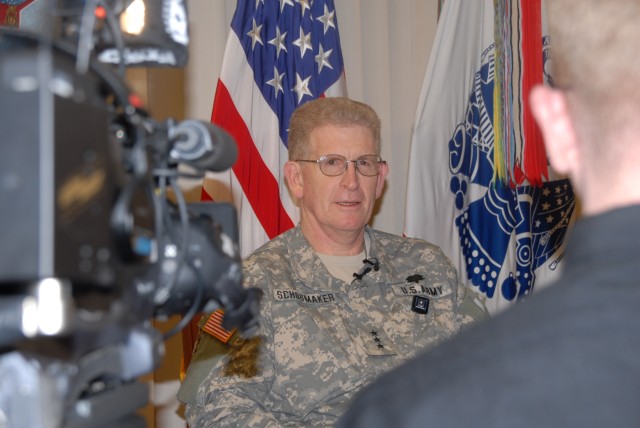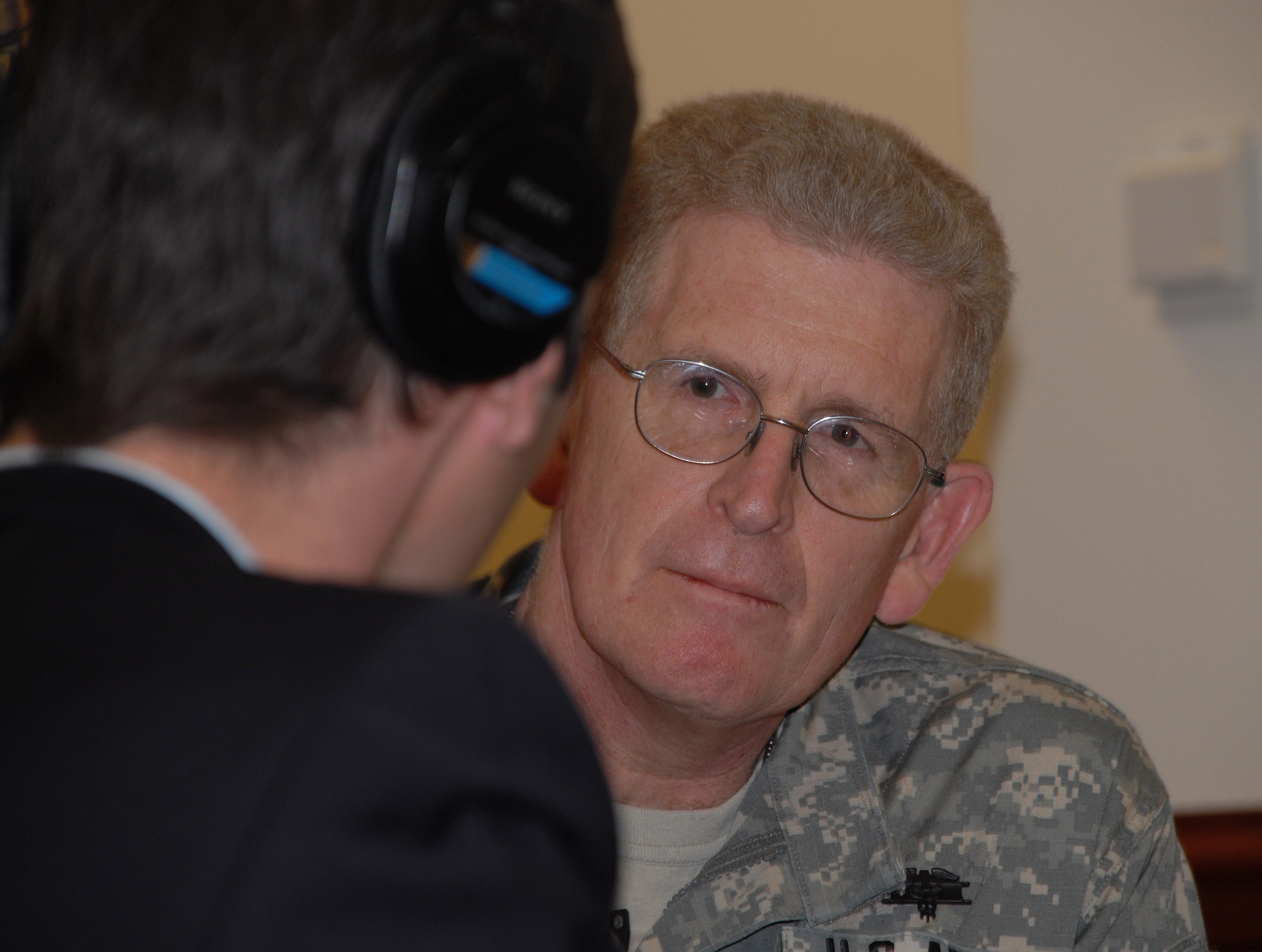WASHINGTON (Army News Service, Feb. 8, 2008) -- One year after the Army began answering to publicity surrounding outpatient deficiencies at one of its leading medical facilities, it's top doctor announced, "We have made major revisions in our approach to care for our Soldiers and their families."
During a media roundtable Thursday, Army Surgeon General Lt. Gen. Eric B. Schoomaker and other representatives from the Army medical community discussed progress made since the stories about Walter Reed Army Medical Center surfaced.
The Army Medical Action Plan, formed to implement changes that would improve medical care processes and reduce bureaucracy, has enabled vast improvements in the way Army medicine assists and transitions its wounded and ill warriors, Schoomaker said. One of the main components of AMAP, the Warrior Transition Unit, has been a staple of the transformation.
<b>Warrior Transition Units</b>
There are currently 35 WTUs providing medical and administrative support to some 9,500 wounded, injured and ill Soldiers to date, the general said. In the past, those Soldiers would have been imbedded in various units throughout the Army.
"Now we are bringing them all together - those who are ill, injured in training (or) in combat - all components," Schoomaker said, added that the majority of WTU Soldiers are not casualties of war, but have other service-related injuries and illnesses.
Each WTU is manned with squad leaders, nurse case managers and primary care managers (physicians) to provide for the various needs of Soldiers and their families. The Army has provided more than 2,500 Soldiers from outside the medical community to work in various roles within the units as well, according to Schoomaker.
"These are Soldiers taking care of other Soldiers and their families," he said.
<b>Time to Transition</b>
The Army's goal is to navigate Soldiers through the oftentimes lengthy and difficult channels that lead to recovery and eventually transition.
"All Soldiers receiving care and evaluation are 'Warriors in Transition,'" Schoomaker said. "They are in transition back into uniform to serve again, in transition into their civilian life (or) in transition to continued care at a VA or civilian facility." He also praised other changes ushered in by AMAP intended to smooth these transitions, including better coordination with the Department of Veterans Affairs.
The VA has placed recovery coordinators and liaisons in Army hospitals, "to identify friction between agencies," and better guide Soldiers and their families through such bureaucratic processes as disability ratings and benefits, Schoomaker said. In its efforts to cut through what used to be miles of red tape encountered during a Soldier's transition process, the Army has been working closely with the VA. Through AMAP, major strides have been made, "to eliminate hurdles and improve the adjudication process to make the transition process as fluid as possible," he added.
Officials are investigating, testing and implementing ways to reduce bureaucracy across the board, such as reducing paperwork, according to Brig.Gen. Michael Tucker. The assistant surgeon general for warrior care and transition, Tucker cited the reduction of the physical evaluation packet by 50 percent as one success in this arena.
The Army has also provided Soldiers with more time for transition preparation, according to Schoomaker. Prior to the establishment of the AMAP, Soldiers were given 10 to 12 days to out-process once the decision to discharge had been made. Now, each out-going Soldier is allowed 90 days to prepare for life beyond the Army.
"They are now given the time necessary to prepare for transition that was previously unavailable," Schoomaker said. In addition, with Veterans Affairs representatives in-house, a Soldier's VA benefits can be approved prior to discharge.
<b>Improvements Treating Brain Trauma</b>
Col. Loree Sutton, head of the Defense Center of Excellence for Psychological Health and Traumatic Brain Injury, spoke at the media roundtable about improvements in mental health and brain injury research and treatment.
"There have been numerous advancements in the last few months with respect to mild traumatic brain injuries, Post Traumatic Stress Disorder, depression and anxiety," she said. Mental health professionals, both Army and civilian, will continue to cooperate and share information regarding mental health and brain injuries and the risks associated with them.
Sutton added that a scientific working group would convene later this month to review all areas and discuss ways to better serve affected Soldiers and their families.
"We are looking to take a holistic approach (when dealing with) injury and trauma," she said.
<b>Suicide Prevention</b>
In response to questions about the increased number of suicides, attempted suicides and suicide gestures within the Army, Col. Elspeth C. Ritchie said the Army is addressing ways to decrease the stigma attached to feelings that could lead to these actions.
The behavioral health psychiatry consultant to the Army Surgeon General sited one possible reason for the increase: "Part of the reason the trend has gone up is better capture of data," which she said equates to a more accurate gathering of information on suicides, attempts and gestures.
The Army continues to concentrate its efforts on suicide prevention and research to provide solid support for Soldiers, according to Schoomaker. "Suicide prevention is not purely a medical issue, it is a multi-disciplinary issue," he said.
"It is a problem that involves small unit leaders and fellow soldiers. Chaplains and medics are involved, as are counselors," Schoomaker said, added that the Army is taking an integrated approach to attack the problem where it can provide the most help, using all available personnel and information to educate Soldiers and their families on the signs of suicidal tendencies and ways to recognize and treat the causes.
"This is something we are taking very seriously. We want to be able to effectively help our men and women in uniform," Schoomaker said.
<b>Wounded Warrior Hotline</b>
The Wounded Soldier and Family Hotline is another tool the Army is using to reach out to Soldiers and their families. According to Schoomaker, the hotline has fielded more than 7,000 calls since its inception in March 2007. The 24-hour hotline addresses a wide range of issues, and is available to current and former Soldiers and family members from every Army component.
According to AMAP officials, the hotline serves two main purposes. "To offer wounded, injured or ill Soldiers and their family members a way to share concerns on the quality of patient care," and "To provide senior Army leaders with visibility on medically-related issues so they can properly allocate resources to better serve Soldiers and families." Schoomaker added that it gives members of the Army family an additional avenue to resolve medical-related issues.
If operators supporting the hotline cannot answer a caller's question, they are trained to provide the caller with points of contact and phone numbers to organizations that can offer assistance.
The Army Medical Action Plan's recent successes and future progress hinge upon the continued cooperation between all involved organizations and people, according to Schoomaker: "America can be assured that we are not going to rest until Soldiers serving our nation are cared for compassionately and effectively."
See related story <a href="http://www.defenselink.mil/news/newsarticle.aspx'id=48897"target=_blank> Army Moves Aggressively to Treat Blast-Related Injuries</a>




Social Sharing